 Taste of Abode
Taste of Abode
Chicken Potpie Galette with Cheddar-Thyme Crust
This gorgeous galette takes traditional craven potpie and gives information technology a fun open-faced spin. The rich filling and flaky cheddar-flecked crust brand information technology taste so homey. —Elisabeth Larsen, Pleasant Grove, Utah Get Recipe
Farmhouse Pork and Apple tree Pie
I've always loved pork and apples together, and this recipe combines them nicely to create a comforting principal dish. It calls for a bit of preparation, but my family unit and I hold the wonderful flavor is well worth the effort. —Suzanne Strocsher, Bothell, Washington

Mini Shepherd'south Pies
These savory lilliputian pies may exist made with unproblematic convenience items, only I'one thousand just equally confident serving them to drop-in company every bit I am to my husband and three boys. —Ellen Osborne, Clarksville, Tennessee
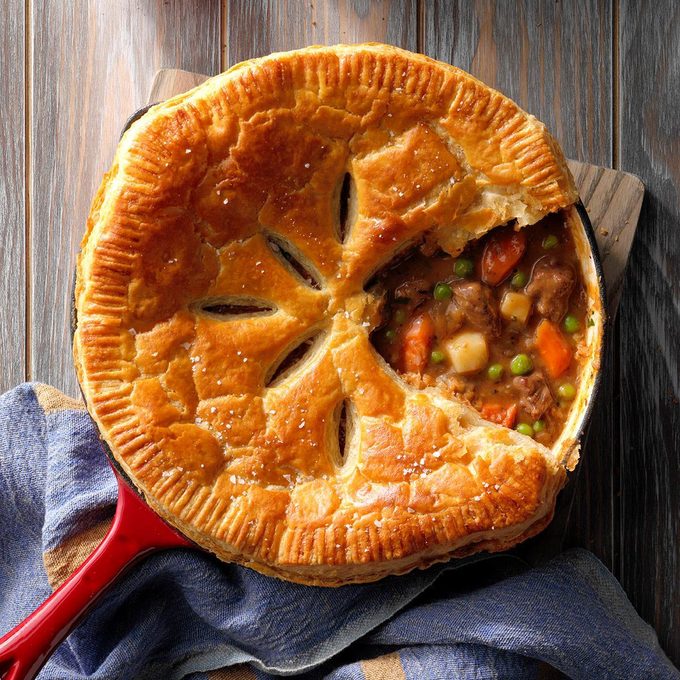
Beef Stew Skillet Pie
Puff pastry makes a pretty topping for this homey skillet potpie. —Josh Rink, Milwaukee, Wisconsin

Mushroom and Sweet White potato Potpie
The last time I was in the U.Southward., I had an amazing mushroom and beer potpie at a small brewpub. It was so rich and comforting. I tried numerous versions when I got dwelling and I recollect I've come up pretty close! — Iben Ravn, Copenhagen, Denmark
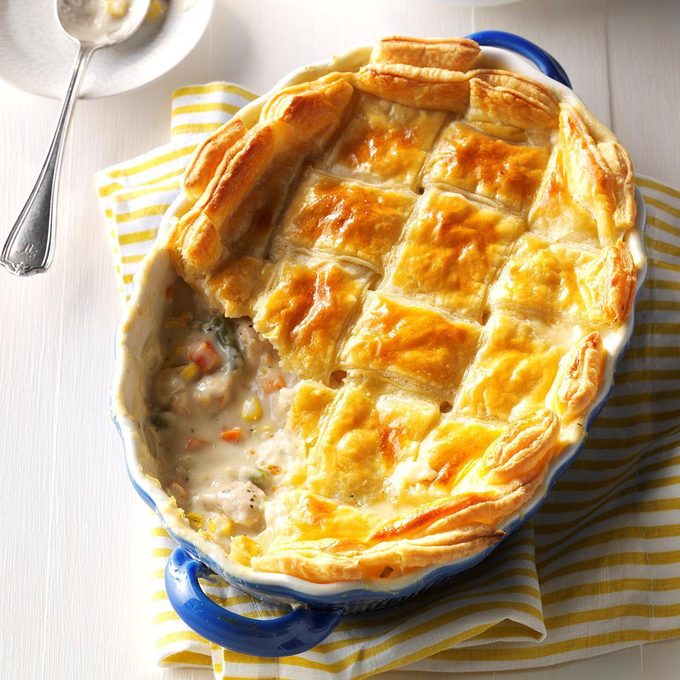
Puff Pastry Chicken Potpie
When my wife is craving condolement food, I whip upwards this chicken pot pie with puff pastry. It'south like shooting fish in a barrel to make, sticks to your ribs and delivers soul-satisfying flavor. —Nick Iverson, Denver, Colorado
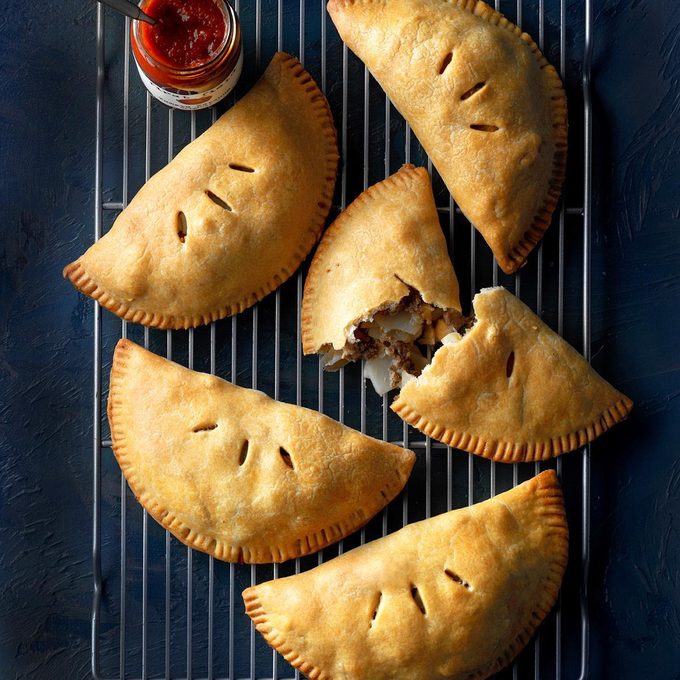
Upper Peninsula Pasties
I grew up in Michigan'due south Upper Peninsula, where many people are of English language ancestry. Pasties—traditional meat pies often eaten by hand—are popular at that place. —Carole Lynn Derifield, Valdez, Alaska

Roadside Diner Cheeseburger Quiche
My savory chief-dish quiche tastes but like its burger counterpart. Like shooting fish in a barrel and appealing, this cheeseburger quiche is pretty enough to serve guests. —Barbara J. Miller, Oakdale, Minnesota
Cheddar Chicken Potpie
Cheese soup is one of my favorites, just information technology's a bit too rich for my hubby's taste. Now I make a variation of potpie we both bask. If I'thou in a hurry, I'll skip the crust, add extra milk and serve it as a chowder. —Sandra Cothran, Ridgeland, South Carolina

Mini Sausage Pies
The simple ingredients and family-friendly flavor of these niggling sausage cups make them a go-to dinner favorite. And everyone gets their own pies—which makes them even better! —Kerry Dingwall, Ponte Vedra, Florida

Sloppy Joe Pie
To be honest, I don't hear many compliments on this dish...folks are ever too busy eating! I developed the recipe by grabbing ingredients from my fridge and cupboards ane "crunch time" when I needed an easy dish fast. —Kathy McCreary, Goddard, Kansas
Curried Chicken Turnovers
Whenever I accept leftover chicken, these turnovers are on the bill of fare. The tasty secret is in the back-scratch. —Laverne Kohut, Manning, Alberta

Senate Bean Potpie
The flavors from classic Senate bean soup inspired this hearty potpie with a cornbread topping. —Janice Elder, Charlotte, North Carolina
Favorite Chicken Potpie
This is the all-time chicken potpie recipe! Clogged of chicken, potatoes, peas and corn, this recipe makes two golden pies, then you lot can serve ane at supper and save the other for a busy night. —Karen Johnson, Bakersfield, California
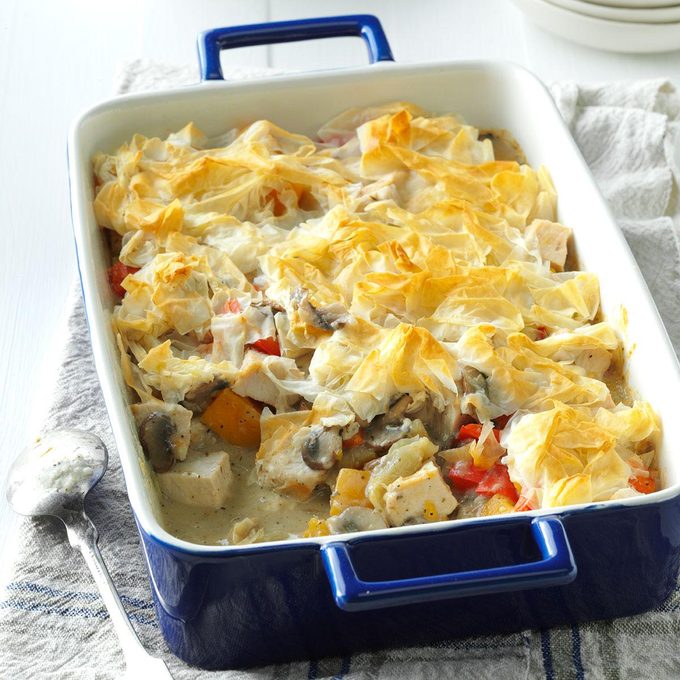
Company Turkey Potpie
Here'south our smart spin on potpie, filled with turkey, fall vegetables and a creamy herb sauce. Best of all, at that place's no crust to brand—just peak with prepared phyllo dough. —Taste of Home Test Kitchen

Mini Pork Pies
As a child, I discovered my dear of pork pies. I used to help my male parent evangelize oil on Saturdays, and nosotros would end at a local place to have the meaty pastries for dejeuner. —Renee Murby, Johnston, Rhode Isle
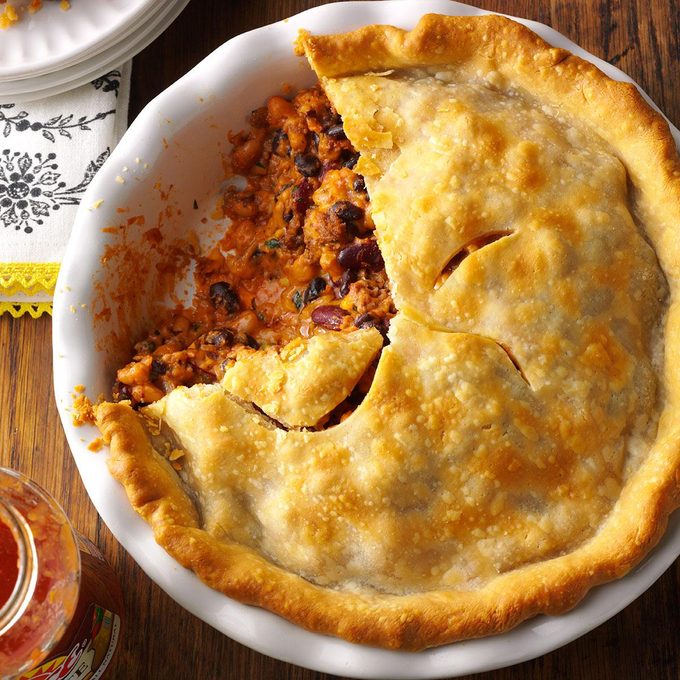
Spicy Bean and Beef Pie
My daughter helped me come up with this recipe when nosotros wanted a one-dish meal that was different than a casserole. This pie slices nicely and is a fun and filling dish. —Debra Dohy, Massillon, Ohio
Nacho Pie
In place of the basis beef and mozzarella cheese, consider topping this zesty pie with lean ground sausage and cheddar cheese. Information technology tastes only as good.—LaVerna Mjones, Moorhead, Minnesota
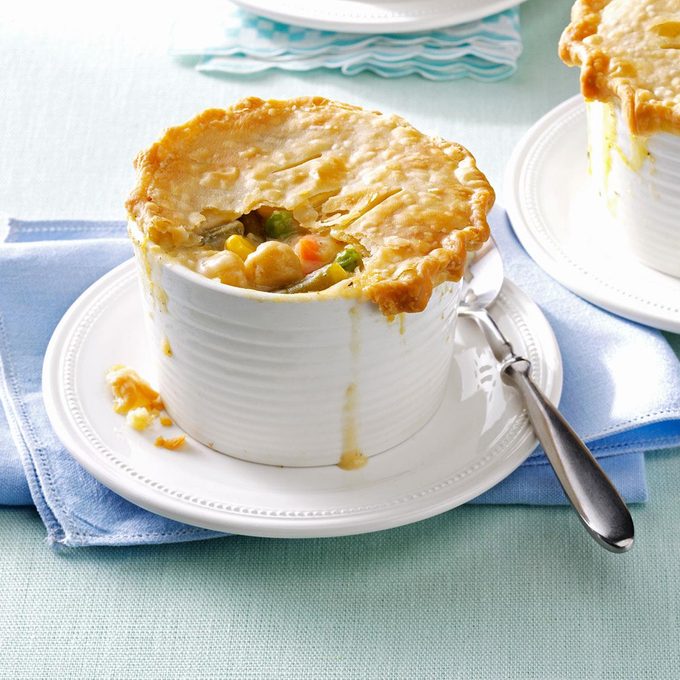
Chickpea Potpies
My family loves potpies, and with this recipe, no i—non even my carnivores—misses the meat. Hungry teens and adults gobble them upwards! —Annette Woofenden, Middleboro, Massachusetts
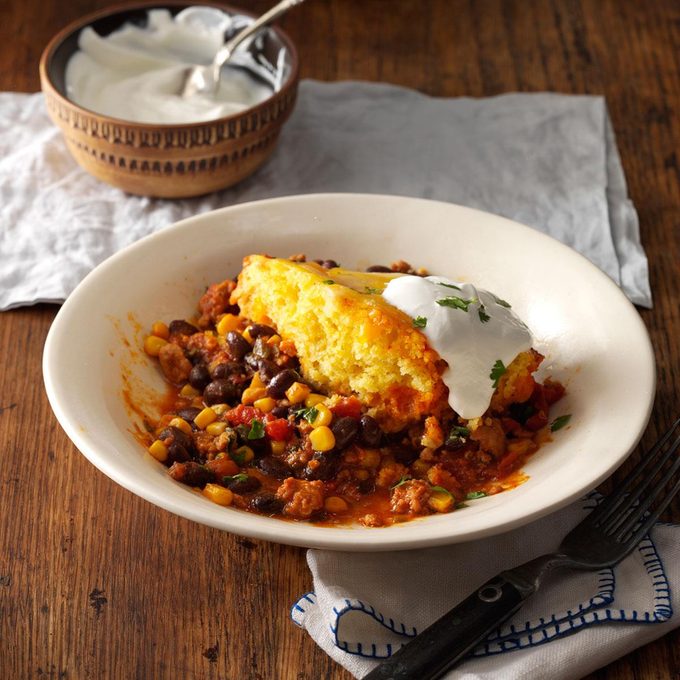
Like shooting fish in a barrel Chicken Tamale Pie
All you need are some simple ingredients from the pantry to put this slow-cooker meal together. I love the fact that I tin can go fishing while it cooks. —Peter Halferty, Corpus Christi, Texas
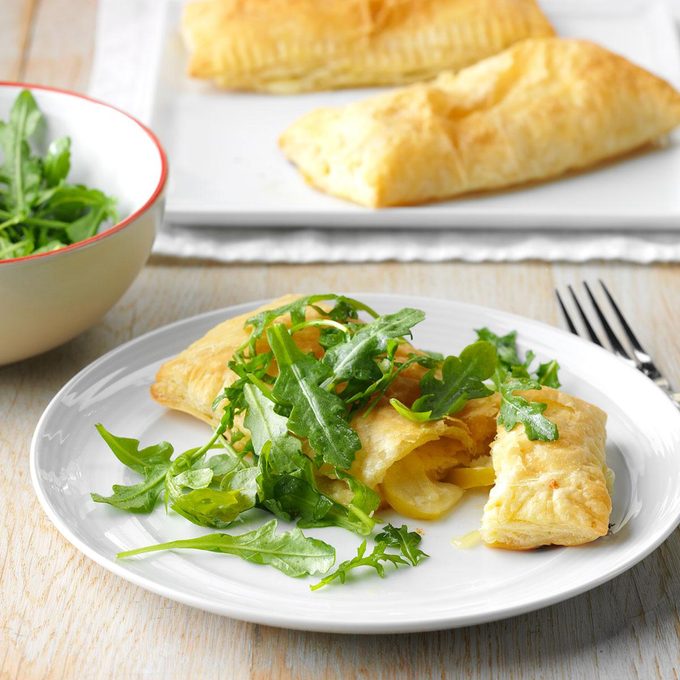
Apple, White Cheddar & Arugula Tarts
These tarts remind me of growing up in Michigan. Add meat if you like or keep it lite. I ever like to garnish it with fried prosciutto. —Maria Davis, Hermosa Beach, California
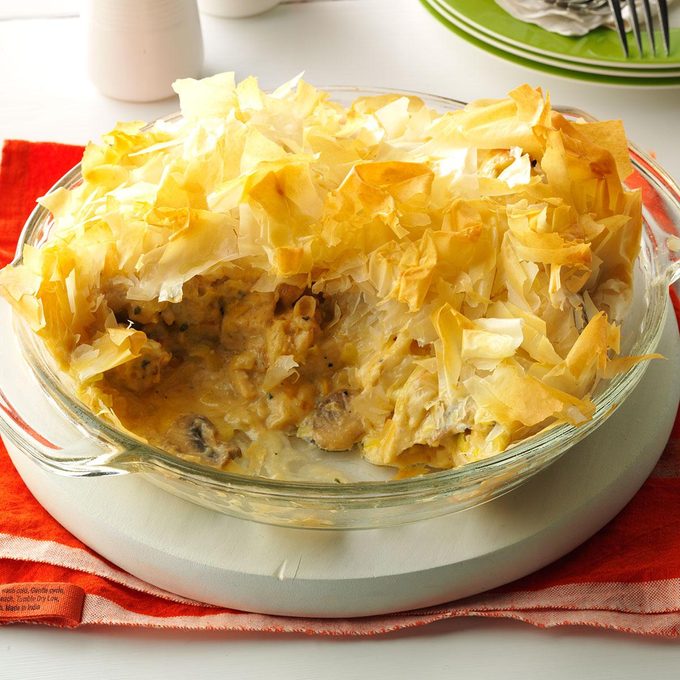
Cheesy Chicken and Leek Phyllo Pie
In our house, chicken potpie is a yr-circular staple. For a springtime feel, we employ leeks and mushrooms and a lighter phyllo dough crust. If you lot don't take gruyere, attempt Parmesan. —Andrea Stewart, Toronto, Ontario
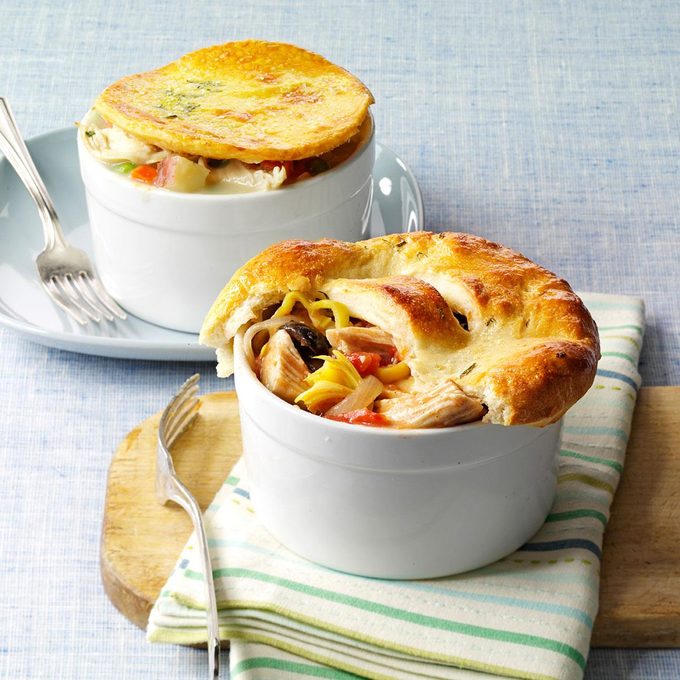
Mediterranean Turkey Potpies
Your clan volition dearest these wonderful stick-to-the-ribs potpies with a Mediterranean twist. I always use the leftovers from our big holiday turkey to prepare this recipe. I think my family unit enjoys the potpies more than the original banquet! —Marie Rizzio, Interlochen, Michigan
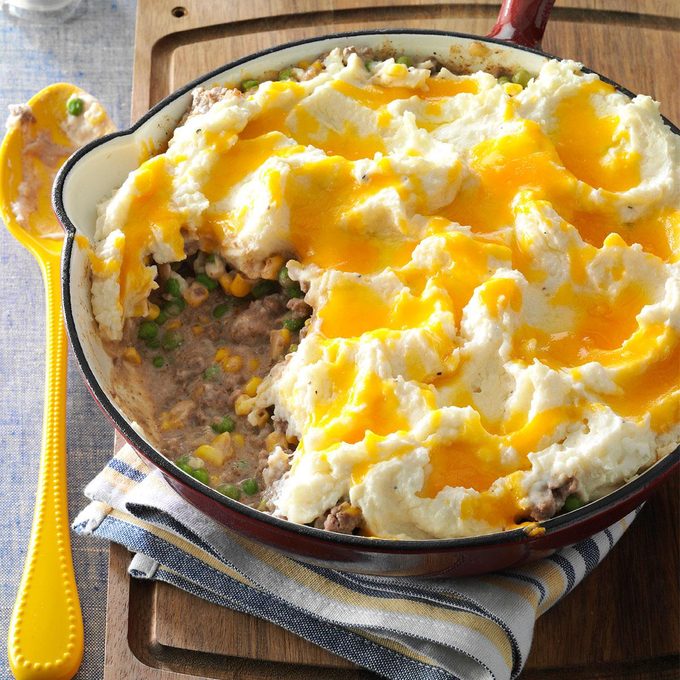
Skillet Shepherd'southward Pie
This is the best shepherd'south pie recipe I've ever tasted. It'due south very quick to make, and I usually accept about—if non all—of the ingredients already on hand. —Tirzah Sandt, San Diego, California
Miniature Meat Pies
I make these handheld pies in advance, keep them in the freezer, then bake them the day of the party. They are always a striking at tailgate and potlucks. —Gayle Lewis, Yucaipa, California
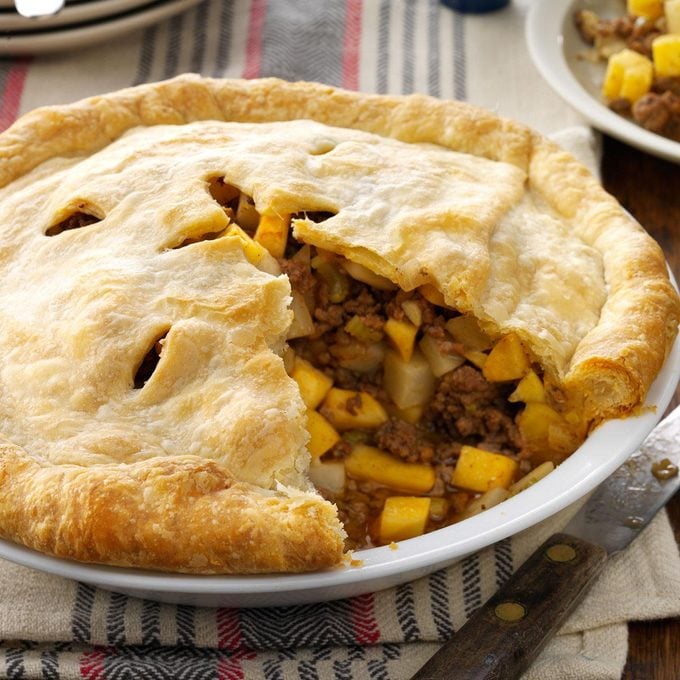
Rutabaga Pie
This is a variation of a recipe my mom used to make. I changed a few things so it's easier to prepare. My whole family enjoys this hearty chief dish. —Patricia Kron, Oak Creek, Wisconsin
Easy Beef Pies
We make a lot of French dips and always take leftover roast beef. Hither's how I put it to good use. For these pies, utilize any vegetables you similar. They're extra awesome drenched in cheese sauce. —Jennie Weber, Palmer, Alaska
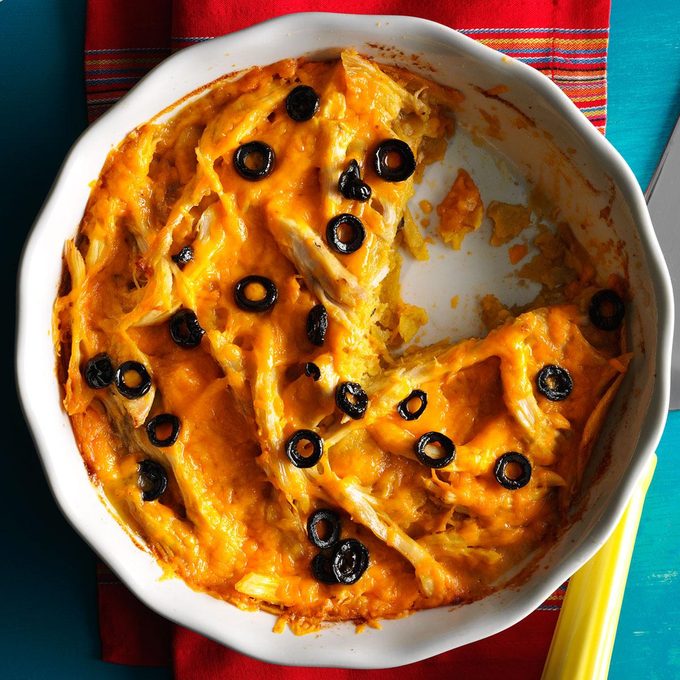
Chicken & Cheese Tortilla Pie
Trust me when I say this hearty dish tin can be assembled in minutes, and so devoured even quicker with no leftovers. —Karen Kuebler, Dallas, Texas

Savory Turkey Potpies
This volition perk you up on a cold, rainy day. Y'all tin utilise chicken in place of turkey, and I like to serve the potpies with a fresh green salad or cranberry sauce on the side. —Judy Wilson, Sun City Due west, Arizona
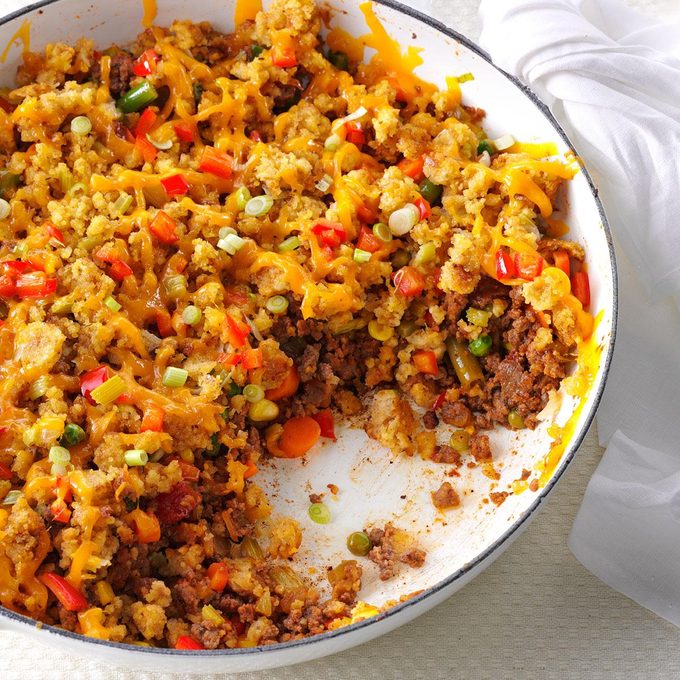
Skillet BBQ Beef Potpie
Beef potpie is a classic comfort food, just who's got time to see it through? My crowd-pleaser is not only speedy but an excellent way to employ leftover stuffing. —Priscilla Yee, Hold, California

Mushroom & Leek Pie
In the Pacific Northwest, nosotros make a savory pie with mushrooms and leeks. We prefer chanterelle, but babe portobello or oyster mushrooms will also delight your diners. —Vickie Woods, Salem, Oregon

Black Bean Tamale Pie
Corn bread mix speeds the grooming of this Southwestern entree with beefiness and blackness beans. My husband actually likes it, and guests seem to bask this unique Mexican dish. For a change of pace, try topping information technology with lettuce, guacamole or extra salsa. —Laura Morris, St. Joseph, Missouri
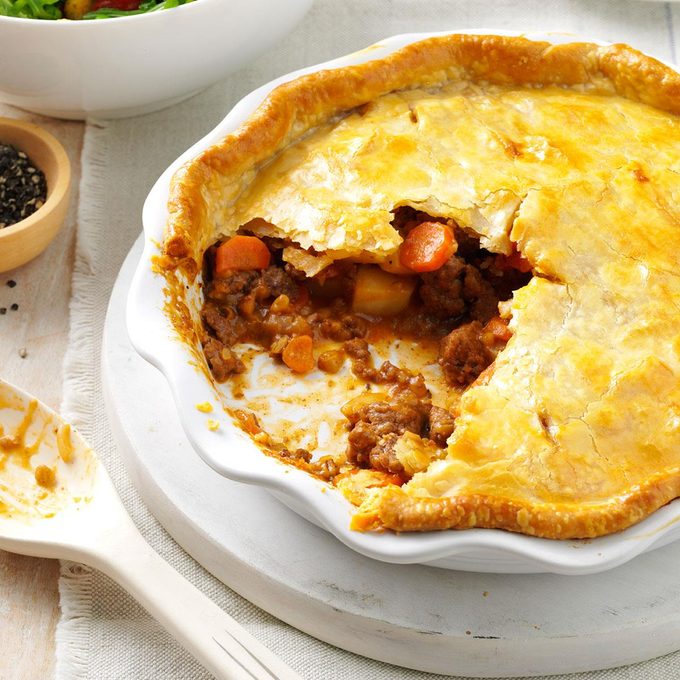
Tasty Meat Pie
I work full time as a nurse, so I depend on quick and piece of cake meals similar this one. My sister suggested I use canned soups instead of prepared gravy. Now my hubby and teenage son inquire for seconds and even thirds. —Cheryl Cattane, Lapeer, Michigan
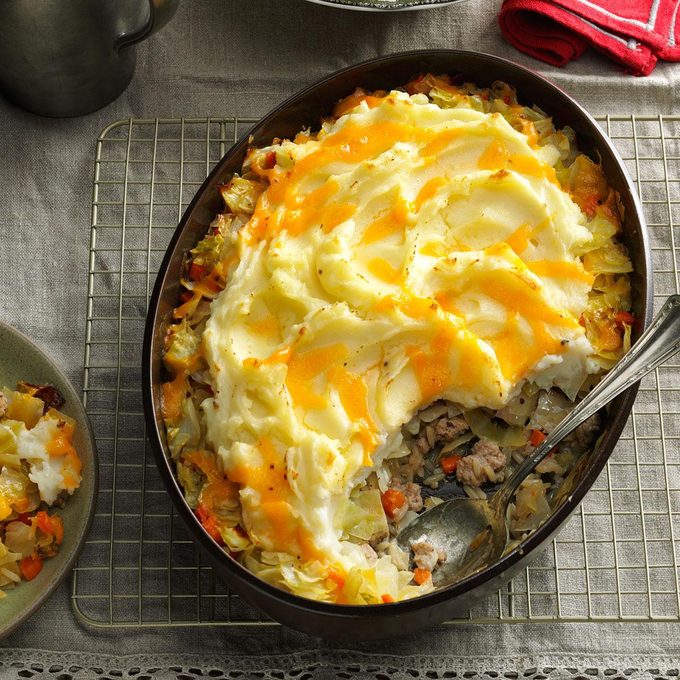
Pork Shepherd'south Pie
Of all the shepherd's pie recipes I've tried through the years, this version is my favorite. Although I live solitary, I enjoy cooking and blistering for friends and family unit. —Mary Arthurs, Etobicoke, Ontario
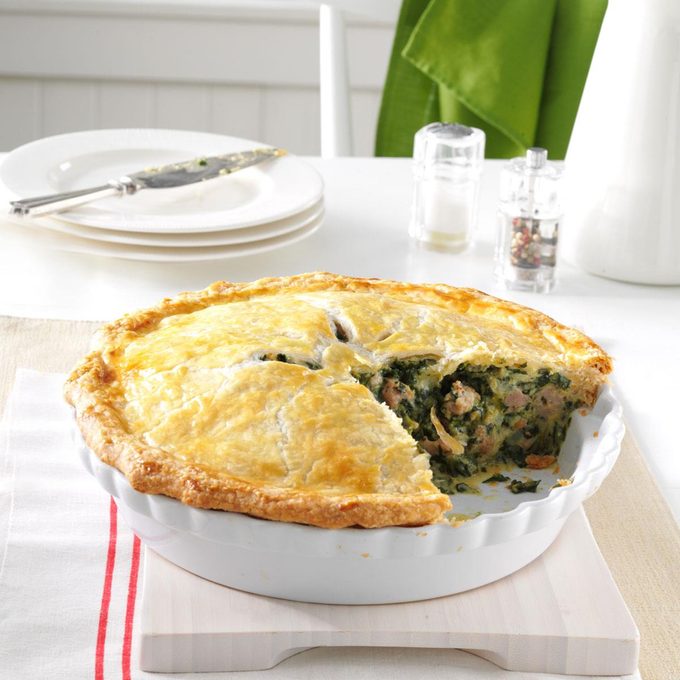
Italian Sausage and Spinach Pie
The basic recipe came from my mother, only I've added a few ingredients. The flavors blend so well, and it fifty-fifty tastes expert common cold. This makes a hearty supper, especially when you serve information technology with a side of pasta. —Teresa Johnson, Peru, Illinois
Beefiness Pot Pie
For more a dozen years, this has been the No. 1 dish to serve company at our business firm. Then far, everyone has given it a thumbs-up rating. —Hannah McDowell, Penns Creek, Pennsylvania

Turkey Lattice Pie
With its pretty lattice crust, this cheesy baked dish looks as good as it tastes. It's easy to make, too, since information technology uses ready-to-become crescent gyre dough. —Lorraine Naig, Emmetsburg, Iowa
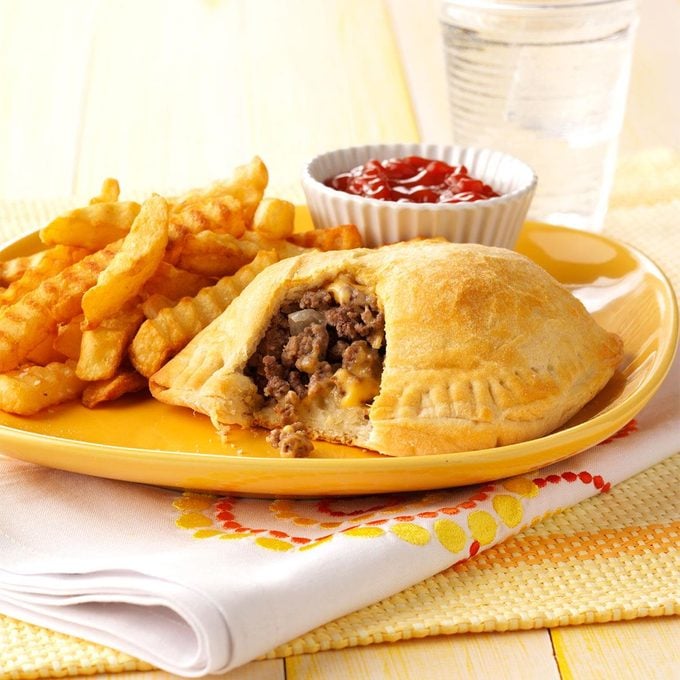
Cheeseburger Pockets
Ground beefiness is my favorite meat to cook with because it's and then versatile, flavorful and economic. Refrigerated biscuits relieve you the problem of making dough from scratch. —Pat Chambless, Crowder, Oklahoma
Spinach Beefiness Pie
I constitute this recipe about 15 years ago, and it's nevertheless i I plow to ofttimes. It's flavorful and pretty.—Meg Stankiewicz, Garfield Heights, Ohio
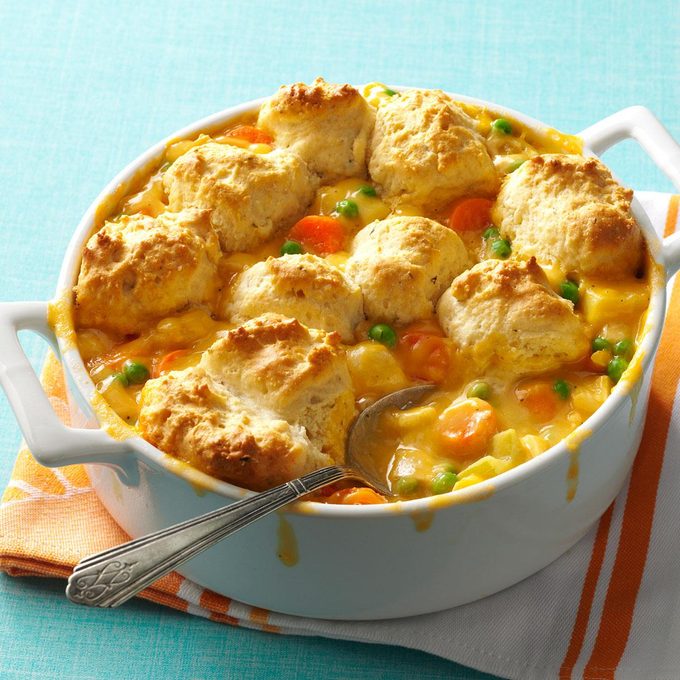
Easy Cheddar Craven Potpie
My kids love chicken potpie, and I really similar that this is and then quick and easy to put together with frozen veggies and store-bought gravy. To make information technology even simpler, my friend and I decided to top it with a biscuit crust instead of homemade pastry. It'southward delicious! —Linda Drees, Palestine, Texas

Provolone Beef Pastry Pockets
My children always make sure they're habitation when they find out nosotros're having these pockets for dinner. They're a smart way to employ leftover pot roast. —Karen Burkett, Reseda, California

Black Bean Tortilla Pie
I institute this southwestern entree a while ago but decreased the cheese and increased the herbs originally chosen for. It's 1 of my toddler's favorite meals. She always smiles when she sees it on the table. —Wendy Kelly, Petersburg, New York
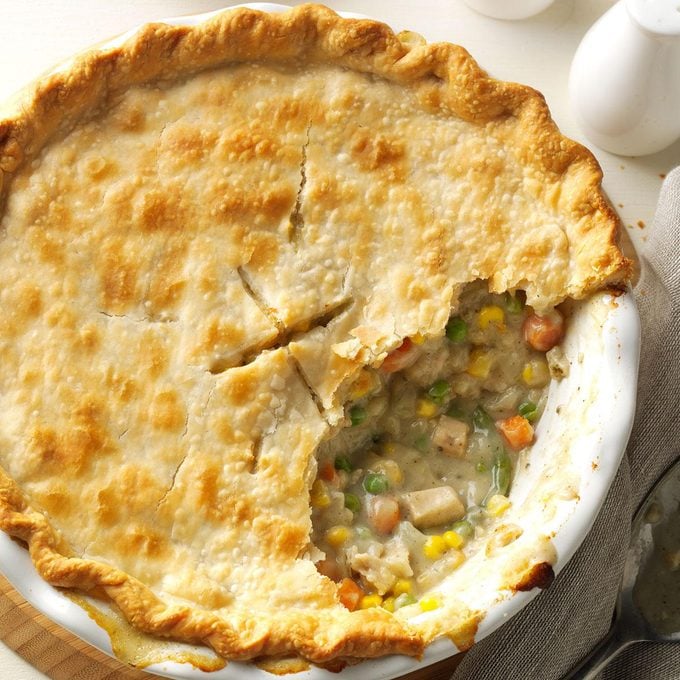
Homemade Craven Potpie
Why look for potpie in the frozen food aisle when this easy version tastes much better? The craven pot pie'due south crust is and so tender and flaky, and underneath you'll find the ultimate comfort food for kids and adults. —Amy Briggs, Gove, Kansas
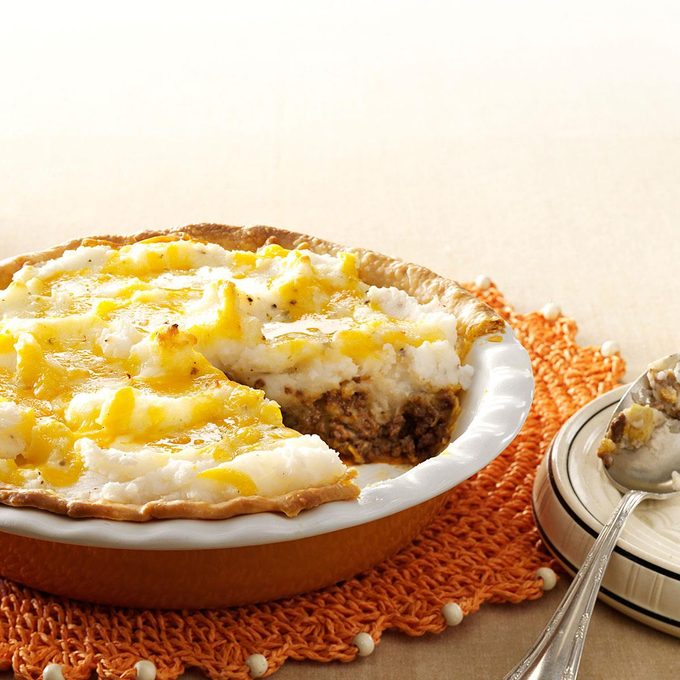
Taco Shepherd's Pie
Watch shop flyers—when lean footing beef is on sale, y'all'll want to stock up. This family unit-pleasing entree is one for the front end of your recipe files! —Sandra Parker, Glen Burnie, Maryland
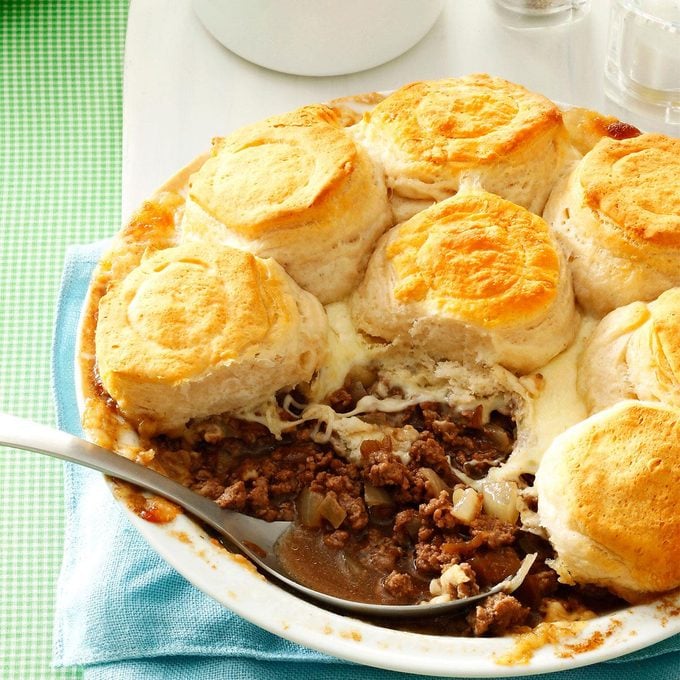
Bulky French Onion Potpie
I came upwardly with this dish knowing my husband loves French onion soup. Information technology'south a skillful base of operations for this hearty, meaty potpie. — Sara Hutchens, Du Quoin, Illinois
Pinwheel Steak Potpie
On cool nights, nothing hits the spot like a steaming bootleg potpie—especially one you can go on the table fast. The pinwheel crust on top has become my signature. —Kristin Shaw, Castleton, New York

Finnish Meat Pie
We enjoy this hearty, traditional meat pie year-round, but especially during hunting season. This is one recipe I'll be sure to pass on to our vii children.— Laurel Skoog, Frazee, Minnesota
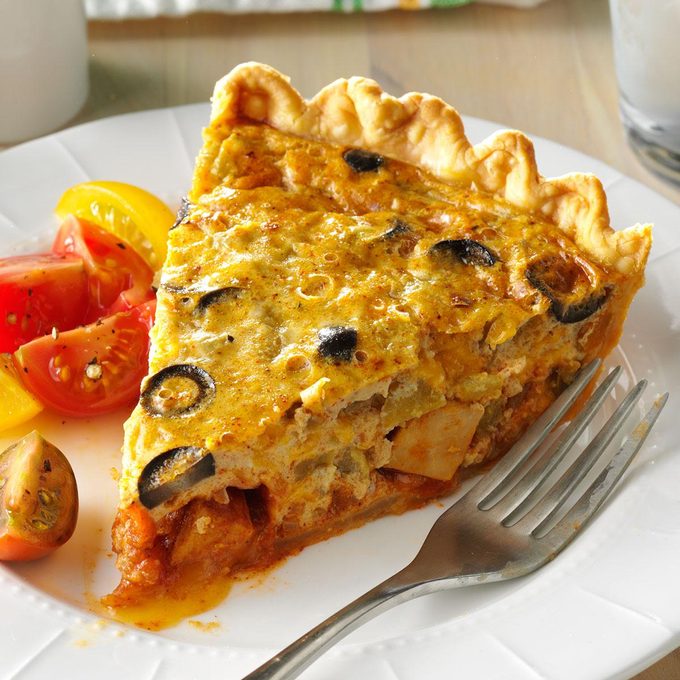
Chicken Taco Quiche
I wanted to make a quiche just didn't want the usual flavors, so I used ingredients I had in my pantry and fridge to come up up with this recipe. I was surprised at the not bad sense of taste and how well the flavors came together. My neighbor asked for the recipe and had the aforementioned success! —Tamie Bradford, Grand Forks AFB, Northward Dakota

Western Beefiness and Cornmeal Pie
With this hearty main dish recipe, the bread is broiled right in the casserole. The meal covers all four nutrient groups, and it's a guaranteed family pleaser. —Darlene Alexander, Nekoosa, Wisconsin
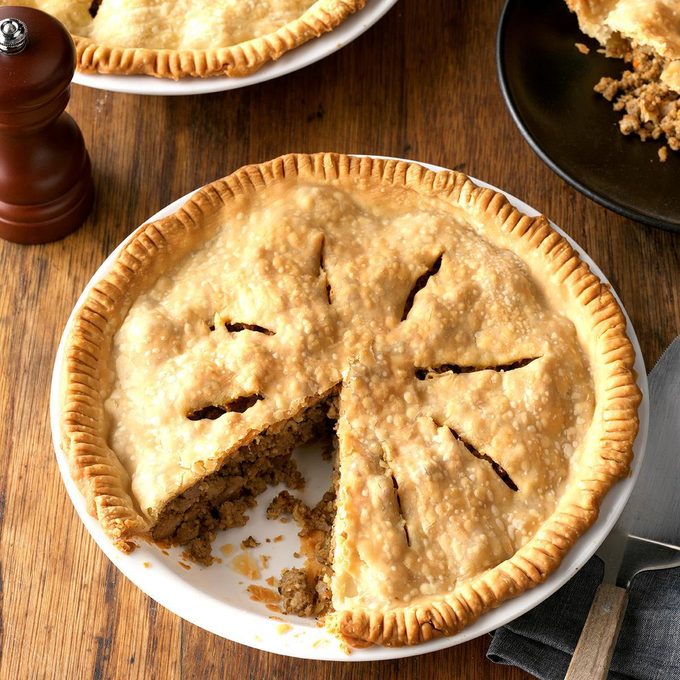
French Canadian Tourtieres
This recipe comes from my big sister. Each fall, we assemble and make most 20 of these pies to use at Christmas, give every bit gifts or freeze for unexpected visitor. —Pat Menee, Carberry, Manitoba
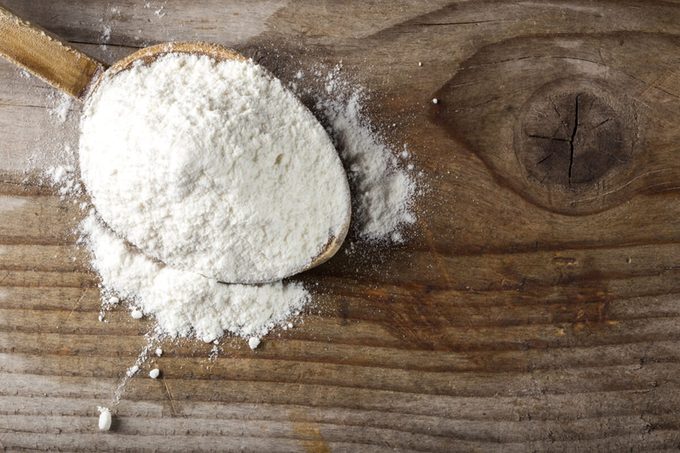








































0 Response to "Cornstarch vs Flour vs Arrowroot—When to Use Which Thickeners?"
Post a Comment